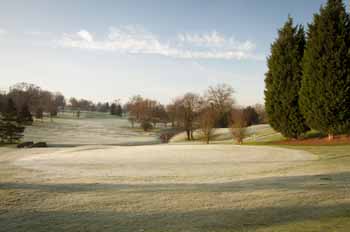Preparing your golf course for winter
Related Articles
Autumn brings with it plenty of changes for greenkeepers. With fewer rounds and more favourable growing conditions, the focus shifts towards winter preparation…
While ‘to-do’ list items to prepare your course for winter depend upon the species of turfgrass you manage, many of the practices listed below are still good precautionary measures to take in order to ready your turf for lower temperatures during the winter months.
Evaluate turf sunlight exposure
Adequate sunlight exposure allows grass plants to achieve the desired rate of respiration, photosynthesis and plant growth. When exposure is compromised, grass plants become significantly weakened, resulting in a depleted root system and lower energy reserves. In turn, this less than optimal condition makes it more difficult for the plant to recover from both wear and winter injury. With shorter days during the winter months, sunlight is already limited. Consider thinning canopies or removing trees that are shading areas of your turf to correct unsuitable lighting conditions. Tree removal can also improve air movement, resulting in a lowered risk of disease on your turf.
Practice deep aeration
Aeration is a good practice to relieve any compaction in the soil profile from season-round foot traffic, heavy equipment or accumulations of excessive thatch. Practicing deep aeration in the autumn when overall turf stress is low, allows for a quicker recovery. Pairing this process with a soil surfactant application can help speed the recovery time even more.

Overseed in combination with a soil surfactant
A good overseeding programme can be key for autumn and winter play, as well as determining the quality of your turf for the upcoming season. When turf is mowed closely prior to seeding, it can cause significant dry down. While important for getting good seed-soil contact, this practice increases the effect of water repellency at and below the soil surface. This heightened repellency can make it difficult for seedlings to establish properly and can lead to wasted water and grass seed. A proven soil surfactant like Revolution, Dispatch or Primer Select will overcome water repellency, enhance water infiltration, and ensure that applied water wets the soil and seed evenly for faster, more uniform turf germination. For best results, soil surfactants should be applied two weeks before seeding to prepare the soil.
Monitor soil moisture
It is important to continually monitor the soil moisture of your greens throughout the season to ensure a healthy return of your turf for the spring. Keeping a record of these levels can also help you compare with winter injury in the spring and allow you to start building a site history. Continue with regular applications of a proven water management product like Revolution, Zipline or Dispatch Sprayable throughout the winter in order to reap the proven turf health benefits that these products provide; promoting a drier and firmer surface, keeping water moving through the profile, providing consistency, reducing surface run off, preventing dry down and hydrophobicity from reappearing, increasing photosynthesis and other metabolic functions as well as assisting with the uptake of applied nutrients.
Ensure adequate turf nutrition
It is vitally important that your turf remains healthy and strong, giving it the best opportunity to withstand harsher weather conditions and combat wear and tear.
The emphasis should be on turf health and not top growth with applications of a proven turf hardener, containing low amounts of nitrogen but adequate amounts of potassium, calcium, magnesium and iron, as supplied by the ‘Tough Turf’ combination from Aquatrols.
There is no way to control what the winter season has in store for your turf, but you can take precautionary measures and be best prepared.

























